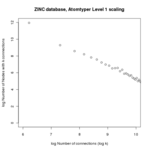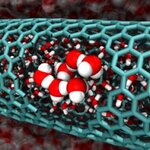Chemistry

Are students inspired to go into physics because of a television show like "The Big Bang Theory"? Probably not, or else 60% of America would be cops and lawyers.
But chemistry has a bad reputation, argues a recent editorial in Nature Chemistry, and "Breaking Bad" gets some of the blame for keeping its reputation bad. It's a cable show on AMC, so not exactly on the minds of all that many people, but it chronicles the transformation of Walter White from suburban high school chemistry teacher to crystal meth dealer and criminal mastermind who uses his chemistry expertise (…

I just now dug up this from the Science Codex:
Milestone: A methane-metal marriage
relating how the group of Lucy Ziurys at the University of Arizona have found a promising new way of making methylzinc, and published it at the end of last year. Compounds like this have been known since the mid-nineteenth century, but it appears that the new method might require much smaller overheads for industrial scale use, as well as being exciting new chemistry.
However, this immediately makes me think of the related compound diethylzinc, which one generally only encounters in textbooks,…

Chemistry
space refers to the combinatorial and
configurational space spanned by all possible molecules (i.e.
those combination of atoms allowed by the rules of valence in
energetically stable spatial arrangements). It is estimated that the
total number of possible small organic molecules populating chemistry
space could exceed 1060
— a number that exceeds the total number of atoms in the known
universe, and is vastly greater than the number of molecules that
have actually been isolated or synthesized.
Chemistry
space is, of course, more than an
uncategorized list of possible molecules.…

There are rules in making presentations to people - in wine sales, for example, as we outlined in The Science Of Wine And Cheese, you buy on bread and sel on cheese because eating cheese is the way people get the most positive taste. In science, if the audience wants to be inspired, talk about large motion in space and show Hubble pictures. If they like the 'physics is soooo weird' kind of science, go small. There are always strange and unexpected things at the nanoscale, even for the most common materials such as water.
In the last few years, small tubes of graphite or…
I was catching up on chemistry news over the lunch hour and discovered this little gelatinous gem:New Strategy for Expression of Recombinant Hydroxylated Human-Derived Gelatin in Pichia pastoris KM71 You're wiggling and jiggling with excitement, right?
For those staring blankly at the title, wondering what caught my eye, it's the "human-derived gelatin" part. A quick search turned up a blogosphere all aflutter at the news of a human-based bowl of Jello in our snack-pack future.
Mmm, ground-up animal-derived collagen for my afternoon snack
Gelatin is denatured collagen (mainly…

Industry does quite a lot of basic research today but government funds the majority. Prior to and during World War II those ratios were inverted and the private sector funded most basic research in hopes that the next big thing would be invented by them.
Sometimes failed experiments even led to terrific...toys. Silly putty is one example. Silly putty resulted from a mislabeled bottle of what scientists thought was boron nitride at a GE research lab in New Haven, Connecticut. The year was 1943, the middle of World War II, and U.S. private industry had essentially…

In the weekend science category, Yogen Fruz has announced, based on findings found by Proteste.org and reported in O Globo, that they are officially the only frozen yogurt brand based on the new standards for food titled as "Frozen Yogurt." They say laboratory tests confirmed evidence that Yogen Fruz is the only brand that serves real frozen yogurt and will change how frozen yogurt is globally defined, and they say Brazil now leads the charge for countries around the world, to follow the same path and uphold product standards.
Over the past several weeks, they…

A combination of forest byproducts and crustacean shells may be the key to removing radioactive materials from drinking water, researchers from North Carolina State University have found.The new material is a combination of hemicellulose, a byproduct of forest materials, and chitosan, which are crustacean shells that have been crushed into a powder. It not only absorbs water, but can actually extract contaminates, such as radioactive iodide, from the water itself. The material forms a solid foam and has potential applications beyond radioactive materials. The researchers found…

Scientists are launching a three-pronged attack on one of the most obstinate puzzles in materials sciences: what is the pseudogap?
They used three complementary experimental approaches to investigate a single material, the high-temperature superconductor Pb-Bi2201 (lead bismuth strontium lanthanum copper-oxide). Their results are the strongest evidence yet that the pseudogap phase, a mysterious electronic state peculiar to high-temperature superconductors, is not a gradual transition to superconductivity in these materials, as some have long believed.
Instead, it is a distinct phase of matter…

In the days of yore, organic chemistry was considered a branch of science that dealt with endless interactions involving carbon atoms as atomic and molecular interactive forces were not understood. With the obscure determination and blatant optimism of the alchemist predecessors, chemists set their sights on isolating and synthesizing a wide array of compounds; some observed in nature, others dreamt up by their imaginations.
Chemists are particularly drawn to molecules that behave like ferocious cats, reacting rapidly and often violently and hence cannot seem to resist the temptation to…